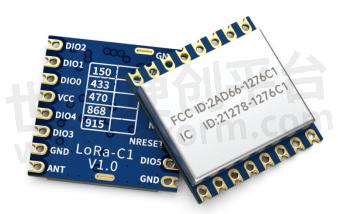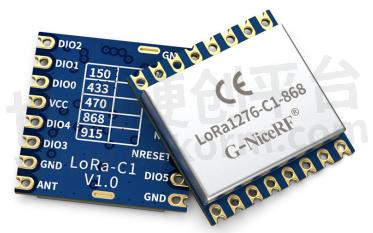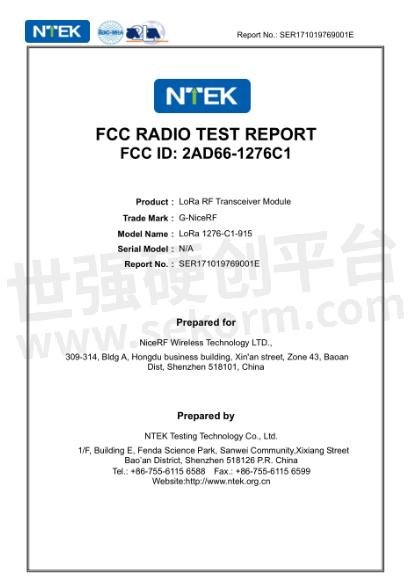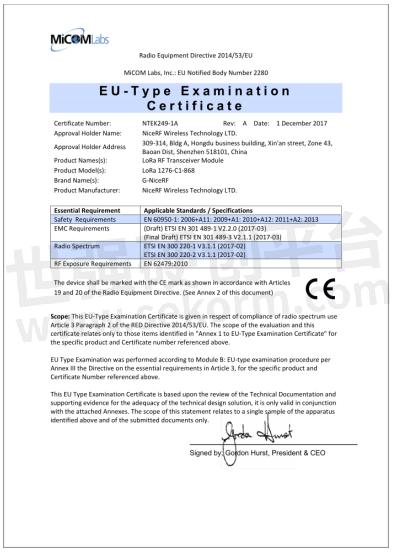LoRa1276-C1 Wireless Module with Output Power of 100mW is Suitable for Industrial Applications, Has Obtained FCC, IC, and CE certifications

The LoRa1276-C1 wireless module utilizes Semtech's SX1278, which features highly efficient reception sensitivity and exceptionally strong anti-interference performance through LoRa spread spectrum modulation and frequency hopping technology. Its communication distance and reception sensitivity far exceed those of current FSK and GFSK modulation techniques. Moreover, multiple transmitted signals can occupy the same channel without interference, demonstrating exceptional resistance to interference. With a design output power of 100mW and compact size, the module finds extensive use in industries such as wireless meter reading and remote industrial control.

For industrial applications, everyone knows that LoRa technology has the advantages of low power consumption and long-distance communication, which are very suitable for industrial control. However, in addition to selecting the right technical solution, a comprehensive module with excellent performance is also a key consideration. Below are a few performance advantages of the LoRa1276-C1 wireless module.

Through FCC, IC, CE certification:
FCC certification: Federal Communications Commission (FCC) is the federal regulatory agency in the United States responsible for managing wireless communications and electromagnetic spectrum. FCC certification requires wireless modules to comply with EMC (Electromagnetic Compatibility) standards and RF (Radio Frequency) radiation regulations in the United States. With FCC certification, wireless modules can be legally sold and used in the US market.

IC Certification: Industry Canada (IC) is the department responsible for managing wireless communications and electromagnetic spectrum in Canada. IC certification requires wireless modules to comply with Canada's Radio Standards Specifications (RSS) and Electromagnetic Compatibility (EMC) standards. After obtaining IC certification, wireless modules can be legally sold and used in the Canadian market.

CE Certification: CE certification is the product safety certification mark of the European Community, applicable to products sold in the European market. CE certification requires wireless modules to comply with European technical standards and regulations, including the Electromagnetic Compatibility (EMC) Directive and the Radio Equipment and Telecommunications Terminal Equipment (R&TTE) Directive. After obtaining CE certification, wireless modules can be legally sold and used in the European market.

-139dBm Ultra-high Sensitivity
Generally, the lower the value of receiver sensitivity, the stronger the receiver's ability to detect weak signals. This means that even in more distant or adverse environmental conditions, the can still communicate stably. Industrial control and civilian applications typically have different requirements for the sensitivity of wireless communication. Industrial control often requires a receiver sensitivity level between -120dBm and -140dBm to ensure good signal reception in industrial environments. The LoRa1276-C1 wireless module with a receiver sensitivity of -139dBm meets the requirements of many industrial control applications.
Low Power Mode
Performance-oriented low-power modules typically correlate closely with the current consumption. The current consumption during operation depends on the workload and operating mode, usually ranging from several milliamps to tens of milliamps. The standby current consumption during sleep mode should typically be at the microampere level, usually ranging from several microamps to tens of microamps. The LoRa 1276-C1 wireless module has an operating current of 10.8mA (transmit power 20dBm), and the sleep current can be lower than 1.5μA, making it suitable for low-power industry applications.
Built-in Antenna Electrostatic Protection
Built-in antenna electrostatic protection refers to the integration of specific design electrostatic protection circuits inside the wireless communication module. It is used to protect the antenna and the wireless communication module from electrostatic discharge or electrostatic interference. Electrostatic discharge can damage the circuits and components of , including antennas, wireless modules, and connected equipment. To prevent such damage from electrostatic discharge, the LoRa 1276-C1 integrates an antenna electrostatic protection circuit internally. This circuit effectively absorbs and disperses the energy generated by electrostatic discharge, preventing damage to the antenna and wireless module.
Other features:
Customizable frequency range: In addition to conventional channels at 433/490/868/915 MHz, it can be customized from 137 to 1020 MHz
Data transfer rates: 1.2-300 Kbps @FSK, 0.018-37.5 Kbps @LoRa
Maximum transmission power of 20dBm, with a dynamic range RSSI of 127 dB
256-byte FiFo and CRC frequency hopping function
Low battery indicator light
Operating temperature range: -40 to +85 °C
In summary, the LoRa 1276-C1 wireless module excels in industrial applications due to its outstanding performance. It has obtained FCC, IC, and CE certifications, ensuring compliance with technical standards and regulations in various regions or countries and enhancing product competitiveness. Its ultra-high receiver sensitivity (-139dBm) guarantees stable communication even in complex environments. Additionally, its low-power design ensures energy efficiency and stability. The built-in antenna electrostatic protection further enhances reliability and durability. Overall, the LoRa1276-C1 wireless module has wide-ranging applications in fields such as wireless meter reading and remote industrial control, providing users with reliable and efficient communication solutions.
- +1 Like
- Add to Favorites
Recommend
- G-NiceRF LoRa Backscatter Device LoRa1276-C1 Provides Long-Range Communication with Low-Power
- G-NiceRF‘s FCC Certified Products for Wireless Transceiver Module: LoRa1276-915, RF2401PRO, RF2401F20, RF4463PRO
- What is the RSSI Function of LoRa Module
- Market Price and Development Prospects of LoRa Module
- G-NiceRF LoRa1121 Module Newly Released: Enables Multi-Band Compatibility and Satellite Communication Functionality
- LoRa126X Series LoRa Modules: Designed Specifically for the Internet of Things
- DEMO kit tutorial of LoRa module LoRa1262
- G-NiceRF’s New LoRa Spread Spectrum Modulation SOC Wireless Module LoRa-STM32WLE5 with Built-in ARM and Industrial Grade Crystal Oscillator
This document is provided by Sekorm Platform for VIP exclusive service. The copyright is owned by Sekorm. Without authorization, any medias, websites or individual are not allowed to reprint. When authorizing the reprint, the link of www.sekorm.com must be indicated.

































































































































































































































































































































































































































































































































































































































































































































































































































































































